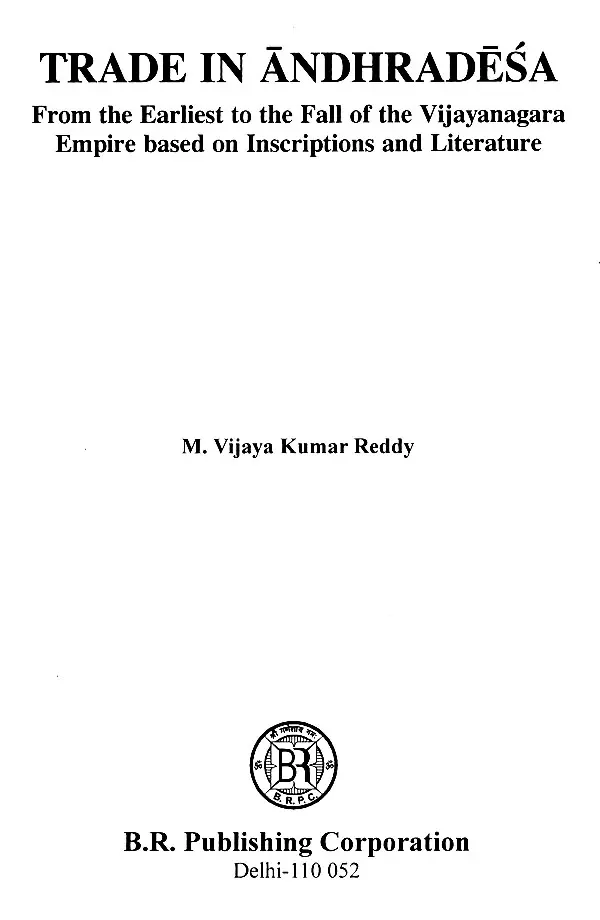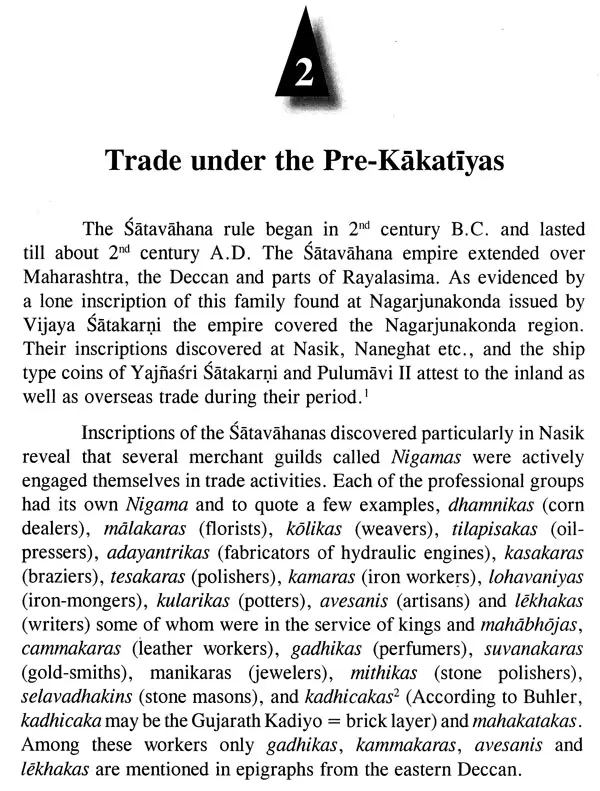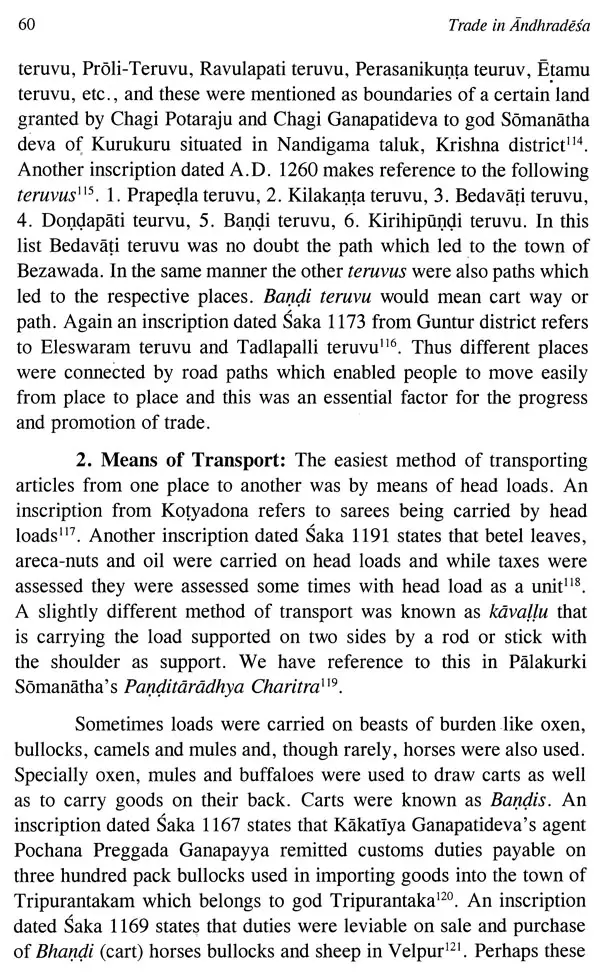
Trade in Andhradesa- From the Earliest to the Fall of the Vijayanagara Empire based on Inscriptions and Literature
Book Specification
| Item Code: | UAS116 |
| Author: | Vijaya Kumar Reddy |
| Publisher: | B.R. Publishing Corporation |
| Language: | English |
| Edition: | 2020 |
| ISBN: | 9789388789462 |
| Pages: | 127 |
| Cover: | HARDCOVER |
| Other Details | 9.50 X 6.50 inch |
| Weight | 370 gm |
Book Description
Trade and commerce in Andhra has a long history. From the earliest times it played an important role as the centre of trade and commerce as evidenced by a large number of inscriptions and archaeological findings. Because of its long coastal line several port towns like Ghantasala, Kothapatnam, Motupalli, Machilipatnam, etc., came up in Andhradesa and the sea-borne trade was continuous and rewarding. The perennial rivers like Krishna and Godavari were navigable and quite helpful for internal trade. It is well established that trade in Andhradesa was carried on uninterruptedly from 3rd century B.C to the fall of the Vijayanagara Empire. The present book discussed the minute details of trade and commerce and the role played by various merchant guilds in different periods in its promotion, has been discussed in detail. The inscriptions, literature, travelogues and the local records have been successfully exploited for the present work. This book also contains various aspects to grasp and evaluate agriculture, industry, production, market and economy. This is first of its kind in Andhra to reconstruct the commercial history of Andhradesa from earliest times to 17th Century A.D.
Dr. M. Vijaya Kumar Reddy (b. 1974) did his M.A in Ancient Indian History, Culture and Archaeology, Ph.D and PG Diploma in Epigraphy in Sri Venkateswara University, Tirupati. He also completed his ICSSR Post Doctoral Fellowship on Trade in Andhra Desa; Based on Inscriptions and Literature. His field of specialisation is Epigraphy and Cultural History. He has published 15 research papers in reputed journals and presented 20 papers in National and International Conferences/Seminars. He is a member in many academic bodies. He is an upcoming writer, who by his approach uncovers little known facets of history, which by themselves contribute to an understanding of the overall historical picture. The present book is largely based on his Doctoral thesis.
Trade and commerce in Andhradesa has a long history. The epigraphical evidences shows that trade and commercial organization like Nigama and Sreni were in existence by the 3rd century B.C itself. The Bhattiprolu casket inscriptions (3rd Century B.C) mention Nigamas. An inscription from Ghantasala (2 century A.D.) refers to a mahanavika. The inscriptions of the Satavahanas reveal the existence of a number of merchant guilds belonging to various professional groups. The double-mast ship coins of the Satavahanas, a large number of Roman coins found in different parts of Andhra country and also the archaeological remains at various places attest to the flourishing state of overseas trade. This has boosted the state revenue and resulted in the rise of many nagaras or mercantile towns. In other words this gave rise to urbanization. Internal trade also developed to a great extent as evidenced by a large number of inscriptions and literature. Because of its long coastal line several port-towns like Ghantasala, Motupalli. Machilipatnam etc. came up in Andhradesa and the sea-borne trade was continuous and rewarding. The perennial rivers like Krishna and Godavari were navigable and quite helpful for internal trade. It is well established that the trade and commerce in Andhradesa inclusive of east coast was carried on uninterruptedly from the 3rdcentury AD to the fall of the Vijayanagara period.
After the fall of the Satavahanas, the Andhra country was ruled by a number of royal dynasties upto Vijayanagaras. A large number of inscriptions issued by these dynasties, and literature has of this period supply rich information for the reconstruction of the history of trade and commerce. All these dynasties paid their attention for the promotion of internal and external trade. They realized the importance of trade and commerce to fill their treasury.
The present book written by Dr. M. Vijaya Kumar Reddy has discussed the minute details of trade and commerce in Andhra from earliest to the fall of the Vijayanangara empire. This is divided into six chapters and spread in about 160 pages. This book though small in pages presents a sumptuous material worthy of research in more conspicuous way. The language is simple, effective and unambiguous in presenting the material. It is a micro study of growing trade and commerce against the background of various fine facets in the same geographical environs. In fact no comprehensive work on trade and commerce was not brought out so far and this book will certainly fill that need.
The scholar has established that the traders from Karnataka, Tamilnadu, Gujarat, Kerala and other parts of the country had trade links with the traders of Andhradesa and they were free from political ramifications. He also identified the fact that many people from all the communities were also involved in trade. Even the Brahmins were also involved in trade. This shows the individual freedom to choose their professions.
Trade involves exchange of goods by way of buying and selling. It can be said that trade begins where civilization begins. Trade under the Harappan and Vedic civilization is too well known to be recounted here. As far as Andhradesa is concerned the epigraphical evidence shows that trade and commercial organizations like Nigama and Śreni were in existence by the third century B.C. itself. The Bhattiprolu casket inscriptions mention Nigamas. Many inscriptions of the Satavahanas give a list of skilled workers atleast some of whom were traders. The trade and commerce during the early centuries of the Christian era between the Andhra and Roman countries boosted the State revenue. Because of its long coastal line several port towns like Ghantasala, Motupalli, and Machilipatnam came up in the Andhradesa and the sea-borne trade was continuous and rewarding. The pre-requisites for trade are navigable rivers, safe ports and inland routes and favourable governments. Inspite of mountains and thick forests important towns, cities and villages were well connected by trade routes. The perennial rivers like the Krishna, Godavari, except in rainy season, were navigable and quite helpful for internal trade. As noted earlier State was also much interested in extending patronage to trade as it would fill its treasury. No doubt at times because of wars trade suffered set back but it was only for a brief period. Under the favourable circumstances soon it could rise again to its earlier state of flourishing. It is against this backdrop that the history of trade in the Andhra country deserves special attention.
Book's Contents and Sample Pages














